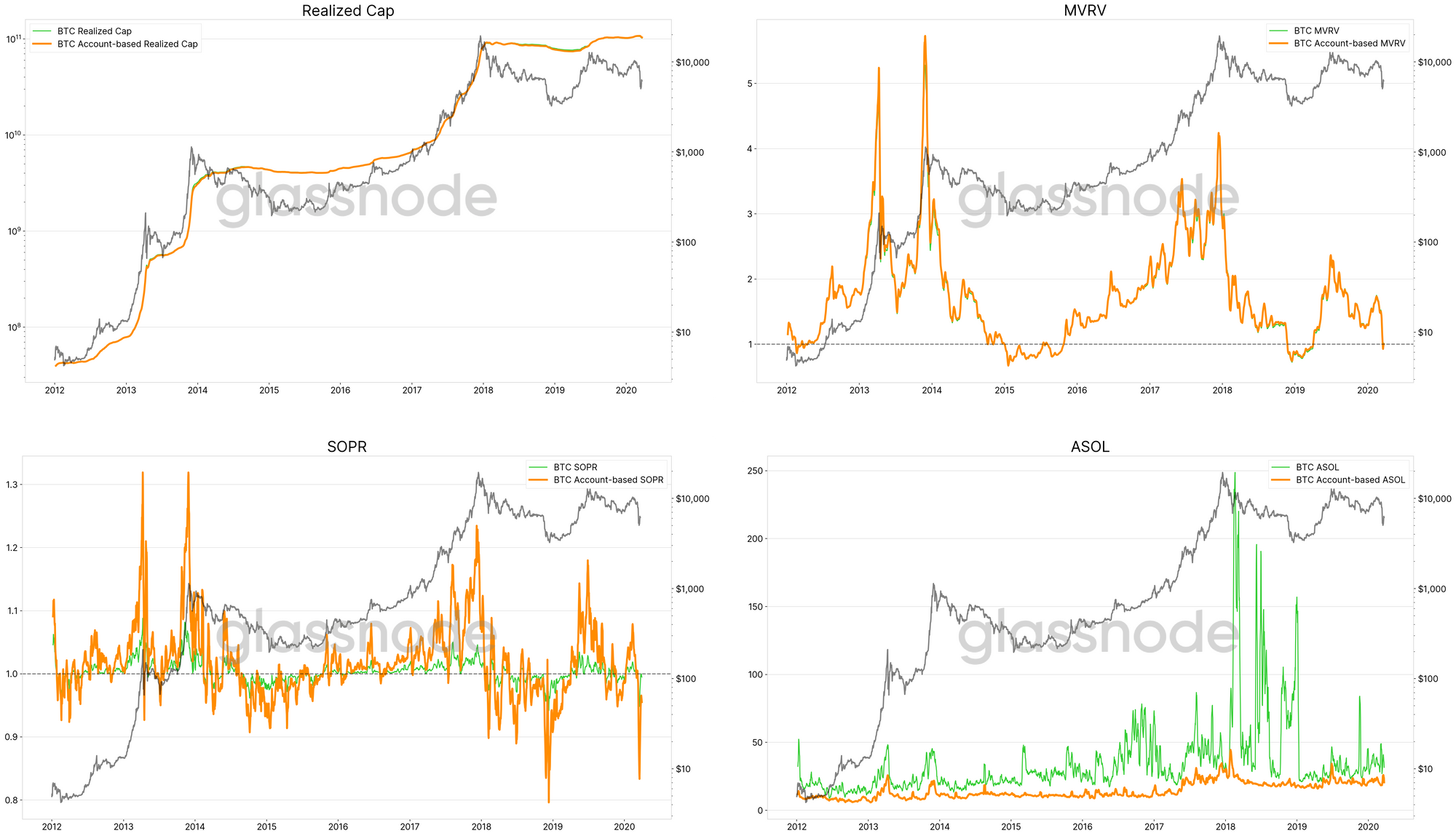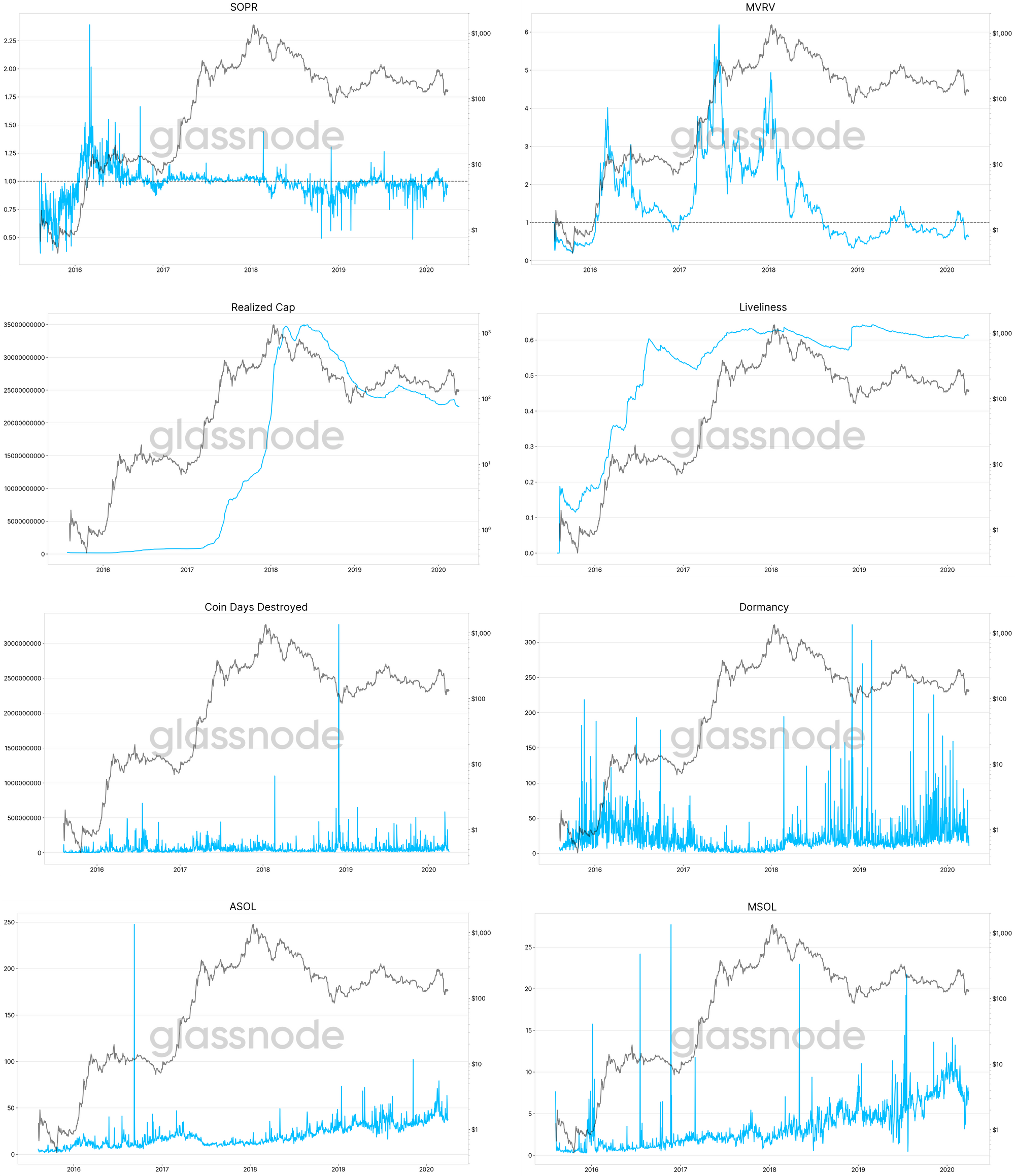Introducing Account-Based On-Chain Metrics for Bitcoin and Ethereum
Effectively mapping UTXO-based on-chain metrics to improved account-based versions for Bitcoin and Ethereum.

By Kilian Heeg and Rafael Schultze-Kraft
Abstract. Numerous on-chain metrics for crypto assets based on the Unspent Transaction Output (UTXO) scheme, such as Bitcoin, suffer from undesired contributions due to change volume or internal transfers, which overshadow the true market behavior signal. In the present work we use the concept of entities, to map UTXO-based blockchains to an effective account-based model and enable the computation of metrics without the aforementioned limitations. In addition, we show that many metrics, originally designed for UTXO chains, can be straightforwardly realized for real account-based systems like Ethereum. We expect that this work forms the basis to provide novel and unprecedented insights of on-chain market behavior.
The Problem with UTXO-based Metrics
A fundamental difference between Bitcoin and Ethereum is that Bitcoin is based on the Unspent Transaction Output (UTXO) scheme, while Ethereum is an account-based system.
Nowadays a myriad of on–chain indicators make use of the UTXO design. However, these often suffer from undesired contributions that can significantly overshadow the true market behavior signal.
Example I: Change Volume
Let’s assume that a single market participant intends to sell 1 BTC, and his or her UTXO has a value of 10 BTC. Neglecting fees, the transaction output will be split into two new UTXOs with values of 1 BTC and 9 BTC respectively, where the 9 BTC account for change volume. In such cases a naive metric computation will not recognize the 9 BTC as an internal transfer (transfer of bitcoins within addresses controlled by the same entity) and instead assume the total 10 BTC as the transferred value. This way, the true market behavior can be overestimated and the metric gives rise to incomplete or incorrect information.
We’ve covered the issue of change volume in our research on Glassnode Insights, and have integrated change-adjusted volume metrics.
Example II: Average Purchasing Price
Consider a market participant who buys 1 BTC for the price of $1200 and some time later another 2 BTC for $3000, such that he or she controls two UTXOs with values 1 BTC and 2 BTC, respectively.
If the user now decides to sell 1 BTC for the price of $3000, what is the resulting profit ratio?
From an account-based perspective, the user’s averaged purchasing price per BTC is $1200 · 1/3 + $1500 · 2/3 = $1400, thus resulting in a profit ratio of $3000 / $1400 ≈ 2.14. From an UTXO-based point of view, either the first, the second, or even both UTXOs can be spent, leaving some ambiguity on the actual profit ratio.
These examples are related to the fact that a market participant generally does not control one single UTXO (or address), which can be visualized as a single yarn, leading from one transaction to the next. Instead, a user or an entity usually controls many of UTXOs, or, to stay with the picture, a clew of yarns. Each of these yarns can start and end at different points and are sometimes tied together, indicating a transaction with multiple inputs or outputs. To extract the most reliable data out of the blockchain requires looking at the clew, not the individual yarns.
Thus, looking solely from the UTXO point of view, some of the actual net activities in UTXO-based chains can be overshadowed and distorted.
At Glassnode, we have previously tackled this issue using advanced heuristics and data science methodologies. For more information refer to our research on Bitcoin entities (“How many entities hold Bitcoin?”) and our entity-adjusted metrics.
From UTXO-based to Account-based
In contrast to the Bitcoin blockchain and alike, a second class of cryptocurrencies uses an account-based scheme instead, most prominently Ethereum. For such chains, however, the vast number of metrics developed for UTXO chains cannot be readily applied.
To overcome this limitation, there have been previous efforts to apply the concept of virtual UTXOs. However, due to the many possibilities to assign balance changes to such virtual UTXOs, these UTXOs suffer from ambiguity of their definition. In turn, this hinders their applicability in reliable metrics.
Here, we take a complementary approach and instead map an UTXO-based blockchain together with its UTXO-based metrics to an effective account-based chain and account-based metrics, respectively.
This provides the basis to solve both problems described above:
- First, the UTXO blockchains can be studied from an account-based point of view, enabling metrics in which “noise” due to in-house transfers are naturally eliminated.
- Second, a large set of metrics initially developed for UTXO chains become available for account-based blockchains, such as for Ethereum.
Methodology
As described above, in an UTXO-based blockchain an entity usually controls multiple UTXOs. Each of those has a well defined creation date, creation block and according to the current market price, a well defined creation price.
Our approach defines suitably averaged virtual quantities for the complete set of UTXOs belonging to one entity (the “clew”), which take the role of the averaged purchasing price, purchasing time, or purchasing block number. This averaging is performed analogously to the Example II described above. Furthermore, our approach is based on balance changes per account on the block level, where positive or negative balance changes can be seen as the counterparts to the creation or spending of UTXOs, respectively.
This treatment effectively eliminates the requirement of any UTXOs in the analysis, and hence can be straightforwardly applied to account-based chains as well.
Account-based Metrics
Using this approach, we implemented a first batch of account-based metrics both for Bitcoin and Ethereum:
- Account-based SOPR (BTC, ETH)
- Account-Based CDD (BTC, ETH)
- Account-based ASOL (BTC, ETH)
- Account-based MSOL (BTC, ETH)
- Account-based Liveliness (BTC, ETH)
- Account-based Dormancy (BTC, ETH)
- Account-based Realized Cap (BTC, ETH)
- Account-based MVRV (BTC, ETH)
Valuation: Account-based Metrics for Bitcoin
To evaluate the potential of our account-based formulation and to verify that it yields the expected results, we compared the above account-based metrics for Bitcoin to their original UTXO counterparts. To do so, we applied our previously introduced account (or entity) clustering algorithms on Bitcoin addresses/UTXOs in the computation and eliminated the unwanted relay addresses.
Figure 1 shows four example metrics (Realized Cap, MVRV, SOPR, and ASOL) of this comparison.

There are two main take-aways from Figure 1.
First, for metrics depicting a more global scope of the blockchain and where we don’t expect major differences, there is indeed a significant overlap between the original Bitcoin metrics and their account-adjusted counterparts. Specifically, as shown for the case of Realized Cap and MVRV we observe near perfect agreement.
This result is clear evidence that our methodology for account-based metrics is in fact accurate.
Second, for some metrics we observe larger differences between the original and the account-based version (in Figure 1 shown for SOPR and ASOL), though there’s still qualitative agreement in the long-term behavior and in general trends. Those are metrics that are, in their original form, subject to be highly influenced by unwanted artifacts on a short-term scale, due to internal (“in-house”) transfers, i.e. transactions that happen within addresses of the same entity. Therefore, the account-based (or entity-adjusted versions) of these metrics denote more accurate and robust versions of the original metrics for Bitcoin.
Diving into the Behavior of Ethereum Accounts
Since most advanced on-chain metrics are designed with Bitcoin and its UTXO concept in mind, comparable insights into the Ethereum blockchain are lacking.
Our account-based formalism allows us to compute sophisticated metrics for Ethereum for the first time.
Figure 2 presents an overview of the current set of account-based metrics implemented for Ethereum.

Conclusion
We generalized conventional on-chain metrics designed for UTXOs to make them applicable for general account-based blockchains. This enabled us to compute for the first time a set of accurate metrics such as SOPR, Realized Cap, MVRV, CDD, Dormancy, ASOL/MSOL and Liveliness for Ethereum. Our approach can readily be applied to other account-based cryptocurrencies as well as to ERC-20 tokens.
In addition, we were able to eliminate the entities’ internal transfers, which usually enter the data used in the metric computations. By mapping Bitcoin to an effective account-based chain, such data intrinsically vanishes from the analysis, giving rise to a more clean picture of real on-chain activity.
At Glassnode, we constantly develop novel account-based metrics (stay tuned and sign up below for updates), and continue pioneering new approaches to unleash the full potential of on-chain data.

- Follow us and reach out on Twitter
- For on–chain metrics and activity graphs, visit Glassnode Studio
- For automated alerts on core on–chain metrics and activity on exchanges, visit our Glassnode Alerts Twitter
Disclaimer: This report does not provide any investment advice. All data is provided for information purposes only. No investment decision shall be based on the information provided here and you are solely responsible for your own investment decisions.
